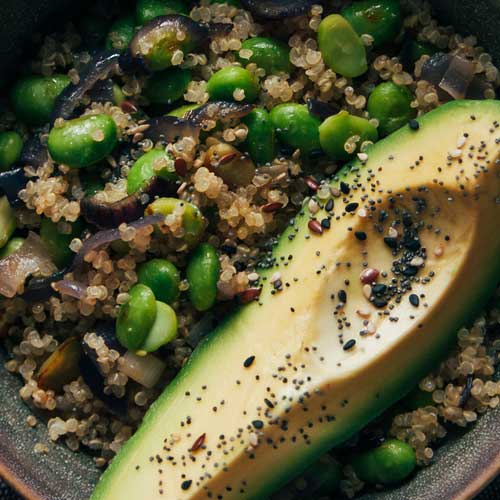
Endometriosis is often addressed with surgical therapy or medical interventions such as hormone replacement therapy.
However, because these methods of therapy often lead to recurrence of endometriosis and have also been reported to cause adverse side effects, some patients have opted to try alternative forms of medicine. Though there is not a tremendous amount of data on the impact of these alternative approaches, certain studies have demonstrated that they hold a lot of promise for minimizing the disease itself as well as the pelvic pain commonly associated with it. In addition, there has been significant anecdotal success with these methods in Asian countries. The use of herbs and acupuncture are two of the most popular alternatives to surgical and pharmaceutical strategies for treating endometriosis. Changes in diet can also be a natural and simple way to improve risks and symptoms associated with endometriosis.
Herbs
There are a number of popular herbal products that have been used for therapeutic reasons, including for endometriosis. One such product is the Chinese formulation Xuefu Zhuyu decoction (XZD), which has been shown to promote fertility in women with endometriosis, reduce the size of the lesions associated with the disease, and reduce the painful menstruation known as dysmenorrhea that often plagues those suffering from endometriosis. A clinical trial showed that XZD was as effective as the pharmaceutical Mifepristone at reducing this pain. Pain reduction and the shrinking of endometrial lesions have also been seen with the product Yi Wei Ning (YWN).
Additionally, herb extracts that are more prevalent around the world may also help those with endometriosis. For instance, epigallocatechin-3-gallate (EGCG), an extract from green tea has been shown to prevent the formation of new endometrial lesions, and reservatrol, which can be extracted from a number of foods including grapes, mulberries, and peanuts, has been shown to slow the growth of such lesions.
Given people’s experience with herbs, as well as the scientific studies into the way herbs can improve the lives of those with endometriosis, herbs may be a good alternative approach to treating the disease. People with allergies, particularly to foods or pollens should exercise caution when trying herb remedies.
Acupuncture
Acupuncture has been used in China since antiquity and has in more recent years gained traction as a credible technique in Western society. The United States National Institutes of Health (NIH) has joined the World Health Organization (WHO) and the United Kingdom’s National Health Service (NHS) is now acknowledging acupuncture as an accepted therapy.
Acupuncture involves the placement of needles on the body for the purposes of enhancing “Qi-Blood circulation,” which is thought to improve the body’s ability to rid itself of harmful toxins, thereby improving its ability to resist diseases. Acupuncture has been clinically shown to improve symptoms for a number of diseases, including endometriosis with fewer side effects than traditional interventions. For endometriosis, acupuncture appears particularly helpful for reducing the pain that occurs during menstruation. Research has shown it to be as effective as pharmaceutical interventions.
In addition to ordinary acupuncture, other versions have been created that may be useful in specific contexts. For instance, moxibustion involves heating different points on the body with burnt herbs to stimulate activity at those points. Warm acupuncture, which involves warming the acupuncture needle with moxibustion, has been shown to be as effective as ordinary acupuncture in minimizing pelvic pain and dysmenorrhea in patients with endometriosis. Another form of acupuncture that may be beneficial for endometriosis patients is known as water injection. This therapy involves injecting substances into specific points on the body.
One of the newest forms of acupuncture is electroacupuncture treatment, which involves subjecting the body to an electrical current. Electroacupuncture is used to relieve pain and organ dysfunction in a number of diseases and has been specifically shown to relieve pain associated with dysmenorrhea in women with endometriosis. Electroacupuncture offers the opportunity to customize the duration and strength of stimulation if a way not afforded by other acupuncture approaches.
Fruits and vegetables appear to be protective against the development of endometriosis.
Diet
Because the activity of estrogen is implicated in the development and progression of endometriosis, some scientists and nutritionists argue that certain diets that help to regulate the levels of hormones like estrogen can be beneficial to those suffering from endometriosis. Some studies have also found that certain substances, such as caffeine and alcohol, can exacerbate symptoms associated with endometriosis and therefore suggest that patients with the disease avoid or minimize the intake of products containing these substances. Red meat, as well as ham, which contains sodium nitrates that are thought to be toxic, have also been reported to be problematic for those with endometriosis
Fruits and vegetables appear to be protective against the development of endometriosis. The caveat is that exposure to certain chemicals, including those found in pesticides that are often used in agriculture can increase the risk of developing endometriosis. Those hoping to improve their risks associated with endometriosis through their diet are therefore advised to stick with organic fruits and vegetables that are not subjected to these chemicals.
Given that alternative methods for treating endometriosis have proven promising, both from anecdotal evidence as well as from controlled scientific studies, there appear to be a number of legitimate options for those who suffer from the disease. Hopefully as research progresses, each woman with the disease will be able to find a therapeutic option that is right for her.
The PMS Mixtape Volume 1
There are variety of moods one goes through when experiencing PMS - sad, angry, tired and vulnerable, just to name a few. So we’ve decided to create some playlists to match how you may be feeling. Yes, it’s The PMS Mixtape!
Instead of going with anything obvious like “Sunday Bloody Sunday,” this first mix is a much more subtle collection of soothing female vocals, starting off with Jenny Hval’s beautiful ambient musings on menstruation. The vibe is tranquilo, Spanish for “Take it easy,” so put it on when you want to chill things out a bit.
| Prep Time | 30 min |
| Servings |
bites
|
- 1 cup cup dried apricots
- 2 tsp water
- 1/2 cup unsweetened flaked coconut
- 1/4 cup ground pistachio
Ingredients
|
|
- In the food processor, add the dried apricot and blend on high until a ball forms.
- Add the water.
- Blend again. You will see the apricot paste start sticking to the sides.
- Using a spatula, transfer the apricot paste into a medium sized bowl. Add the coconut flakes to the bowl and mix until it becomes more uniform.
- In a separate small bowl, add the crushed pistachio.
- Using your hands, take some of the apricot mix and roll it in your palms until it forms a sphere. Make them as big or small as you like but try to keep them similar in size.
- Take each sphere and roll it in the pistachios until is coated from the outside.
- Place in a bowl and enjoy!
| Cook Time | 30 min |
| Passive Time | 30 min |
| Servings |
oatmeal triangles
|
- 1 cup steel-cut oats
- 1 cup water
- 1 1/2 cups almond milk (or substitute nut/rice/soy milk)
- 1 tsp cinnamon
- 1/4 tsp sea salt
- 2-3 tablespoons olive oil
- maple syrup
- strawberries (optional)
- walnuts (optional)
- shredded coconut (optional)
Ingredients
Toppings:
|
|
- In a medium pot, with a heavy bottom, add the water and the almond milk and bring it to a boil.
- Turn down the heat so the liquid is simmering, and add the oats, sea salt and cinnamon. Cover.
- Take an 8 inch square pan and line with parchment. Set aside for when the oats are done.
- Cook the oats for 30 minutes. Stir occasionally during the first 20 min. In the last 10 minutes you have to stir constantly so it doesn’t stick to the pot and it gets creamy.
- As soon as they are done, pour the oats into the parchment lined pan. Level it out evenly using a spoon.
- Cool for 30 minutes on the counter. Then pop in the fridge for another 30 minutes. This will allow the oatmeal to firm up and set.
- Lift the parchment out of the pan carefully and set on a cutting board. With a large smooth knife, cut into four squares, then cut those squares into triangles.
- Heat a large pan with the olive oil, once hot, add the triangles. Don’t crowd the pan and work in batches if needed.
- Cook each oatmeal triangle for 3-4 minutes per side until browned.
- Add to a serving platter and sprinkle on the strawberries, coconut & walnuts. Drizzle the maple syrup on top and enjoy while still warm.
| Servings |
skewers
|
- 8 cups cauliflower florets (around half a cauliflower head)
- 1 tsp garlic powder
- 2 tsp turmeric
- 6 tablespoons sesame oil
- 1/2 tsp salt
- 1/4 cup cilantro (packed)
- 2 tablespoons lime
- 2 tablespoons tahini
- salt to taste
Ingredients
|
|
- Cut the cauliflower into florets big enough to skewer.
- In a big bowl add the garlic powder, turmeric, oil and salt. Mix well.
- Add the florets to the marinade and mix well. Make sure all the florets are coated.
- Add 4-5 florets per skewer.
- To make the sauce, add the cilantro, lime, tahini and a pinch of salt to the food processor. Blend on high until smooth. Set aside in a small bowl.
- Heat the grill on high, and then add the skewers. Cook the cauliflower on medium heat 4-6 minutes per side.
- When done, add the skewers to a serving platter and drizzle some of the sauce lightly over using a spoon. Save the rest to serve for dipping.
If using bamboo skewers, soak them for half an hour before use so they don’t burn on the grill.
If you want to grill them inside, use a griddle or pan and add some sesame oil to prevent sticking.
| Prep Time | 30 min |
| Cook Time | 50 min |
| Servings |
people
|
- 1 beet medium or large
- 1 tsp olive oil (to rub the beet with)
- 1 large garlic clove
- 2 cans chickpeas (3 cups cooked chickpeas)
- 1/2 cup tahini
- 1/4 cup freshly squeezed lemon juice
- 1/2 tsp salt
- 1/2 cup water (to be used as needed)
Ingredients
|
|
- Preheat the oven to 400°F. Wash the beets, rub with olive oil and wrap loosely but securely (so the steam doesn’t escape) in tin foil. Place in a pan in the oven and bake for around 50 min or until the beets are tender. You can gauge the doneness by sticking a fork in the beet (through the foil). If the fork goes in easily, they are done. Remove from the oven and let them cool.
- After they cool, using a knife, peel and discard the outside skin, and cut the beet into cubes.
- If you are using canned chickpeas, put them in a colander or strainer and wash them well. Make sure they are well drained.
- Place the garlic in the food processor and pulse until it is ground up. Then add the chickpeas, tahini, lemon juice, and salt. Let the processor run for a few minutes. Occasionally, push down the chickpeas from the edges to make sure it all gets processed. This is the point to gauge how thick or loose you want the hummus. Add 1-2 tablespoons of water at a time and let the processor run, check the consistency, and adjust with more water as needed. Once it is the consistency you like, let the processor run for a few more minutes to make it as smooth as possible.
- Finally, add the cubed beets to the food processor and blend until it is smooth again.
Even though the recipe calls for one beet, make as many as you like and reserve for Greek salads, or snacking. Add more beets to increase the flavor as you like.
We recommend adding a variety of thinly sliced vegetables instead of chips or crackers for a healthy snack.



